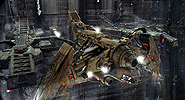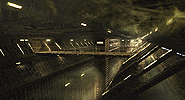
Review

Review
The Auriga and Betty
The sequences of the interior docking bay are extraordinary. A collaborative effort on the part of Hunter-Gratnzer Industries, the company responsible for miniatures in such films as BATMAN & ROBIN and BROKEN ARROW, and Duboi made these shots quite special. The Betty glides gracefully into the bay and docks with the Auriga with believability both in motion and in scale. The extensions to the miniature docking bay, provided as matte paintings by Duboi, are quite invisible and add extra layers of depth to each image. The detail on the miniatures are under an enormous amount of scrutiny in these sequences, since many shots last over five seconds long. The massive amount of steam appearing in these sequences is reminiscent of films like BLADE RUNNER. The filmmakers of RESURRECTION went to great lengths to match the first unit photography in the visual effects shots, and the abundance of steam and mist elements match the abundance of them in the production footage.
The lighting on the miniature Auriga is not cliche--the low key lighting setup on the Auriga was equally motivated and visually interesting. Since the Auriga is stated to be on the outskirts of the solar system, the sun's rays aren't as bright as they would be, for instance, in Earth's orbit. This situtation led to some interesting, low level lighting setups that bring out the mystery and impending doom of the ship.
Of Duboi's 154 shots they composited for ALIEN RESURRECTION, there are plenty that do not call attention to themselves, due to their masterful work at blending their matte paintings and miniature composites into a completely believable shots. Visual effects also that are completely invisible to the viewer's eye are the countless wire and rig removals, executed cleanly and impressively by Vertex International.
The audience is quickly introduced to the main ship of the film, the Auriga--an immense science ship stationed at the outskirts of Earth's solar system. The detail of the model miniature Auriga is immense, giving the accurate sense of scale. Unfortunately, in a few of her shots, the Auriga whips by the camera so quickly that the sense of scale drops a few notches. A mercenary ship, the Betty, zooms over the
camera to dock within the Auriga. The Betty, a fascinating design for a ship, was shot with a number of subtle movements that bring a lot of life to the ship. When the Betty revs up its engines, the heat distortion that they cause seemed a bit flat and two-dimensional, and not up to level of previous heat distortion successes, such as in TRUE LIES and, more recently, STARSHIP TROOPERS.

The Betty docks with the Auriga in one of a series of terrific shots. Models by HGI, compositing and matte paintings by Duboi.
For one particular space shot, where the sun is setting behind the planet in the background, an uncharacteristic digital artifact appears in the shot. Banding of varying levels of white appear in the sun's glow as it descends behind the planet--not often seen in modern digital effects, and especially not characteristic of Duboi's work. Perhaps the flaw wouldn't be as significant, if the sun moving behind the planet were not the focal point of the shot, where the audiences' eyes are drawn.

An uncharacteristic banding occurs within the sun's glow as it moves behind the planet in this shot. Although it is not visible here, it is easily visible on the theatre screen.
Inside the Auriga
In a terrific shot that doesn't reveal itself as a visual effect, the observation room is presented, where a scientist moves about in a huge room via a rotating booth to look at aliens imprisoned in a ring of booths. The shot is utterly convincing, in that nearly the entire frame is a miniature, composited by Duboi. The length of the shot and the movement within it lends a great deal to its believability--had the shot only been a couple of seconds long without any movement at all, it wouldn't have been nearly as successful.
Another classic Duboi matte painting is presented as Call walks across a plank to get to Ripley's cell. Everything except for Call's element (Winona Ryder photographed against a greenscreen) is Duboi's masterwork. The shot is elegant and quite believable, and adds to the epic nature of the film. The only unfortunate thing about the shot is that it is locked down. A slight camera movement could have added a bit more interest to the shot. In addition, the film's editors cut from this effects shot to a production shot of Call reaching Ripley's cell--a shot that begins in the middle of a camera arc. The locked off nature of the previous effects shot became much more apparent with this edit. Whenever a static effects shot cuts directly to a hand held shot or cuts to the middle of a camera crane, I feel that the effects shot is somewhat betrayed; when planning a sequence with effects shots and non-effects shots, the director and editors should respect the sequence, and allow shots' camera movement to blend from one shot to the next, especially in a slow moving, non-action sequence like the one discussed here.

The detail of this corridor shot is extraordinary--on the big screen, the shot is breathtaking.


. . VFX HQ Produced by Todd Vaziri . . http://www.vfxhq.com . . e-mail: tvaziri@gmail.com . .
All text Copyright © 1998 Todd Vaziri, unless otherwise noted